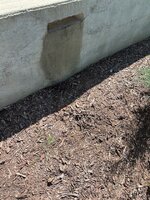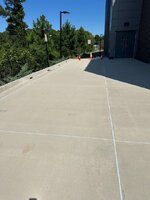I have a wall that landed in the landscape plans (I suspect, but do not know for a fact that structural EoR would like to have taken a look at it but was never asked to by the LA). It is holding up a fire lane and 3-4' of retained earth at its tallest point. The wall is being called a "turn down slab", but I believe it should be a considered a retaining wall with a spread footing. The geotech report has 3,000 psf as the allowable soil bearing pressure. The fire lane would be considered used only in emergency conditions (not frequently loaded).
The wall itself is 10" wide 3,000 psi concrete. Reinforcing is #4 @ 12" oc vertical and #5 @ 12" oc. horizontal (turned back into the slab). I suppose the top of wall could be considered pinned or tied into the slab condition, although it is not poured monolithic with the slab and there is a CJ between the curb/top of wall condition and the structural slab.
The wall has settled around 2" over the last 2 years. It doesn't appear to be in danger of failure, but the design is being called into question on whether a foundation should have been provided.
What would the anticipated bearing pressure be at the stem of the 10" wall at the max retained earth section of 4' (3' plus 1' of cover). To make matters worse, the curb has scuppers at 8' o.c. which allows surface water to sheet down the wall, meaning the bearing condition is almost always wet/saturated.
The wall itself is 10" wide 3,000 psi concrete. Reinforcing is #4 @ 12" oc vertical and #5 @ 12" oc. horizontal (turned back into the slab). I suppose the top of wall could be considered pinned or tied into the slab condition, although it is not poured monolithic with the slab and there is a CJ between the curb/top of wall condition and the structural slab.
The wall has settled around 2" over the last 2 years. It doesn't appear to be in danger of failure, but the design is being called into question on whether a foundation should have been provided.
What would the anticipated bearing pressure be at the stem of the 10" wall at the max retained earth section of 4' (3' plus 1' of cover). To make matters worse, the curb has scuppers at 8' o.c. which allows surface water to sheet down the wall, meaning the bearing condition is almost always wet/saturated.


